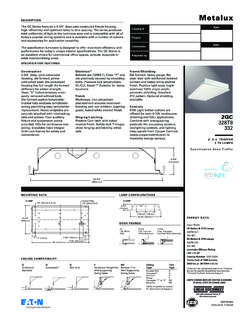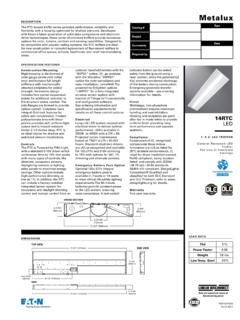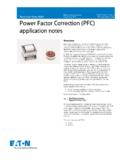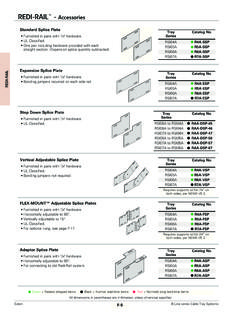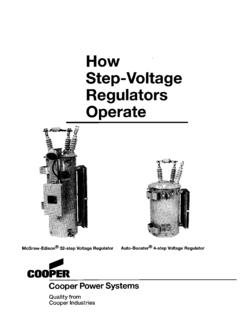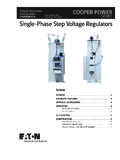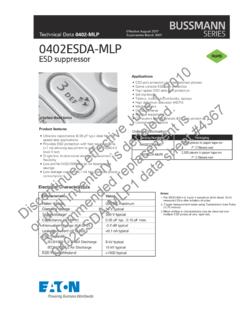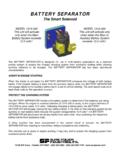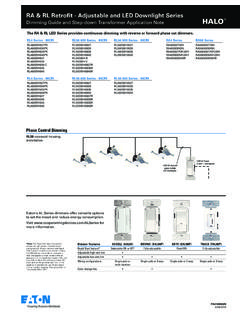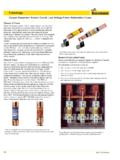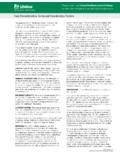Transcription of Fuseology - Cooper Industries
1 Fuseology Cooper Bussmann Branch Circuit, Low Voltage Power Distribution Fuses Classes of Fuses Safety is the industry mandate. However, proper selection, overall functional performance and reliability of a product are factors which are not within the basic scope of listing agency activities. In order to develop their safety test procedures, listing agencies develop basic performance and physical specifications or standards for a product. In the case of fuses, these standards have culminated in the establishment of distinct classes of low-voltage (600. volts or less) fuses, Classes RK1, RK5, G, L, T, J, H and CC being the more important. The fact that a particular type of fuse has, for instance, a classification of RK1, does not signify that it has the identical function or performance characteristics as other RK1 fuses. In fact, the Limitron non-time-delay fuse and the Low- Peak dual-element, time-delay fuse are both classified as RK1.
2 Substantial difference in these two RK1 fuses usually require considerable difference in The illustration above shows Class R type fuse rejection clips, which accept only the sizing. Dimensional specifications of each class of fuse does serve as a Class R rejection type fuses. uniform standard. Branch-Circuit Listed Fuses Class R Fuses Branch-circuit listed fuses are designed to prevent the installation of fuses that Class R ( R for rejection) fuses are high performance, 1 10 to 600A units, 250V cannot provide a comparable level of protection for equipment. and 600V, having a high degree of current-limitation and a short-circuit The characteristics of branch-circuit fuses are: interrupting rating of up to 300,000A (RMS symmetrical). Cooper Bussmann 1. They must have a minimum interrupting rating of 10,000A. Class R's include Classes RK1 Low-Peak and Limitron fuses, and RK5.
3 Fusetron fuses. They have replaced Cooper Bussmann K1 Low-Peak and 2. They must have a minimum voltage rating of 125V. Limitron fuses and K5 Fusetron fuses. These fuses are identical, with the 3. They must be size rejecting such that a fuse of a lower voltage rating cannot be exception of a modification in the mounting configuration called a rejection installed in the circuit. feature . This feature permits Class R to be mounted in rejection type fuse- 4. They must be size rejecting such that a fuse with a current rating higher than the clips. R type fuseclips prevent older type Class H, ONE-TIME and fuse holder rating cannot be installed. RENEWABLE fuses from being installed. Since Class H fuses are not current- limiting and are recognized by regulatory agencies as having only a 10,000A. interrupting rating, serious damage could result if a Class R fuse were replaced by a Class H fuse.
4 The use of Class R fuse holders is thus an important safeguard. The application of Class R fuses in such equipment as disconnect switches permits the equipment to have a high short-circuit current rating. NEC requires that protective devices have adequate capacity to interrupt short-circuit currents. NEC (B) requires fuse holders for current-limiting fuses to reject non-current-limiting type fuses. In the above illustration, the fuse on the right has a grooved ring in one ferrule, providing the rejection feature of the Class R fuse in contrast to the lower interrupting Cooper Bussmann high performance fuses are used in tens of thousands of rating, non-rejection type. industrial plants, commercial buildings, and homes throughout the world. 14 2005 Cooper Bussmann Fuseology Cooper Bussmann Branch Circuit, Power Distribution Fuses Low-Peak Fuses* Now Offer Low-Peak (Dual-Element, Time- Indication That's As Clear As Black Delay).
5 LPS-RK_SP (600 Vac), LPN-RK_SP (250 Vac), 1 10 to 600A, And White Current-Limiting, STD 248-12 Class RK1. Low-Peak current-limiting fuses offer optional permanent LPN-RK_SP 0-60A (125 Vdc, 50,000 AIR), 65-600A (250 Vdc, replacement fuse indication. The indicator is either 50,000 AIR), LPS-RK_SP 0-600A (300 Vdc, 50,000 AIR). black or white; no in between coloring so no second- UL Guide #JFHR, UL File #E56412, 300,000 AIR ac, CSA. guessing whether to replace the fuse or not. Good Class #1422-02, CSA File #53787, 200,000 AIR ac High performance, all-purpose fuses. Provide the very high Proven Technology degree of short circuit limitation of Limitron fuses plus the overload protection of Fusetron fuses in all types of circuits Low-Peak fuses offer the same replacement fuse indication and loads. Can be closely sized to full-load motor currents technology that 's proven itself on the Cooper Bussmann for reliable motor overload protection, as well as backup CUBEFuse fuse and fuse holder system.
6 It's the most protection. Close sizing permits the use of smaller and reliable technology on the market today. more economical switches (and fuses); better selective coordination against blackouts; and a greater degree of * Indication available on Cooper Bussmann LPJ_SPI, LPN-RK_SPI. current-limitation (component protection), Low-Peak fuses (250V) and LPS-RK_SPI (600V). are rejection type but also fit non-rejection type fuse Replace holders. Thus, can be used to replace Class H, K1, K5, RK5 or other RK1 fuses. Low-Peak (Time-Delay) Data Sheet No. 1001, 1002, 1003, 1004. KRP-C_SP (600 Vac), 601 to 6000A, Current-Limiting STD 248-10 Class L. UL Guide #JFHR, UL File #E56412, 300,000 AIR ac, 601- CUBEFuse (Dual-Element, 2000A (300 Vdc 100,000 AIR), CSA Class #1422-02, CSA Time-Delay). File #53787, 200,000 AIR ac TCF (600 Vac), 1 to 100A, The all-purpose fuse for both overload and short circuit Current-Limiting, UL Listed protection of high capacity systems (mains and large Special Purpose Fuse, STD.)
7 Feeders). Time-delay (minimum of four seconds at five 248-8 Class J Performance times amp rating) for close sizing. Unlike fast-acting fuses, time-delay fuses pass harmless surge currents of motors, UL Guide # JFHR, UL File #. transformers, etc., without overfusing or any sacrifice of E56412, 300,000 AIR ac, short-circuit current limitation (component protection). (300 Vdc 100,000 AIR), CSA. The combination use of 1 10 to 600A Low-Peak dual- Class #1422-02, CSA File element time-delay fuses and 601 to 6000A KRP-C Low- #53787, 200,000 AIR ac, Peak fuses is recommended as a total system specification. (300 VDC 100,000 AIR). Easily selectively coordinated for blackout protection. Size TCF fuses meet UL Class J. of upstream fuse need only be twice that of downstream Time-Delay electrical performance Low-Peak fuses (2:1 ratio). Low-Peak fuses can reduce requirements.
8 It is the world's first bus bracing; protect circuit breakers with low interrupting finger-safe fuse with the smallest installed rating as well as provide excellent overall protection of footprint of any power class fuse including Class J, CC, T. circuits and loads. and R fuses. Satisfies requirements of IEC 60529 for IP-20 finger safe rating and provides TYPE 2 no damage . Data Sheet No. 1008, 1009. protection for motor starters when sized properly. The TCF provides open fuse indication and is 35mm DIN rail and panel mountable. Low-Peak (Dual-Element, Time- Data Sheet No. 9000. Delay). LPJ_SP (600 Vac), 1 to 600A, Current-Limiting, STD 248-8 Class J Fusetron (Dual-Element, Time- UL Guide #JFHR, UL File #E56412, 300,000 AIR ac, 1 to Delay). 600A (300 Vdc 100,000 AIR), CSA Class #1422-02, CSA FRS-R (600 Vac), FRN-R (250 Vac), 1 10 to 600A, 200,000 AIR.
9 File #53787, 200,000 AIR ac ac, FRN-R 0-600A (125 Vdc, 20,000 AIR), FRS-R 0-600A. Space saving LPJ fuses have the advantage of time- delay, (300 Vdc, 20,000 AIR), Current-Limiting permitting them to pass temporary overloads, offering overload, STD 248-12 Class RK5. back-up overload, and short circuit protection. Ideal for IEC UL Guide #JDDZ, UL File #E4273, CSA Class #1422-02, starter protection. CSA File #53787. Data Sheet No. 1006, 1007 Time-delay affords the same excellent overload protection as Low-Peak fuses of motors and other type loads and circuits having temporary inrush currents such as those Low-Peak (Time-Delay) caused by transformers and solenoids. (In such circuits, Limitron fuses can only provide short circuit protection). LP-CC (600 Vac), 1 2 to 30A Current-Limiting 200,000 AIR. Fusetron fuses are not as fast-acting on short circuits as ac, Low-Peak fuses and therefore cannot give as high a STD 248-4 Class CC.
10 Degree of component short circuit protection. Like the UL Guide #JDDZ, UL File #E4273, 1 2 (300 Vdc Low-Peak fuse, Fusetron fuses permit the use of smaller 20,000 AIR), 3-15A (150 Vdc 20,000 AIR), 20-30A (300 Vdc size and less costly switches. Fusetron fuses fit rejection 20,000 AIR), CSA Class #1422-02, CSA File #53787 type fuse holders and can also be installed in holders for The Cooper Bussmann Low-Peak Class CC fuse (LP-CC) was Class H fuses. They can physically and electrically developed specifically for a growing need in the industry - a replace Class H, K5, and other Class RK5 fuses. compact, space saving branch circuit fuse for motor circuits. Data Sheet No. 1017, 1018, 1019, 1020. Data Sheet No. 1023. For Data Sheets: 2005 Cooper Bussmann 15. Fuseology Branch Circuit Fuse Dimensions Class CC - in (mm). LP-CC, FNQ-R & KTK-R.
